As an Amazon Associate, we may earn a commission if you make a purchase — at no extra cost to you.
SmartThings vs Hubitat (2025): Zigbee, Matter & Automation Compared
SmartThings vs Hubitat in 2025—see real-world results for Zigbee/Z-Wave, Matter, privacy, and automations. Find the hub that truly fits your smart home needs.
When it comes to a reliable smart home, the smartthings vs hubitat 2025 debate matters—because setup, local control, and device support feel very different in real homes. Both hubs promise broad device support, but smartthings vs hubitat local control and stability show up differently in day-to-day use. This comparison shows smartthings vs hubitat zigbee z-wave behavior, smartthings vs hubitat matter readiness, privacy, and Hubitat Rule Machine vs SmartThings routines. Whether you want the ease of SmartThings or the local control of Hubitat, this guide gives you the clear verdict on which hub is the better fit for your home.
💡 Why “SmartThings vs Hubitat” Matters in 2025 (Zigbee, Z-Wave, Matter, Routines)
Choosing a hub in 2025—especially smartthings vs hubitat—can make or break your setup; even the best smartthings hub won’t beat Hubitat if you need strict local control. With so many devices using Zigbee, Wi-Fi, or new protocols like Matter, it’s easy to feel overwhelmed. This guide simplifies the process so you avoid wasted money, tech headaches, and incompatible gear.
📘 What You’ll Learn: smartthings vs hubitat 2025, local control, and Matter—with real-world results
- 🔌 Smart Home Hub Basics: What a hub does, and when you really need one.
- 🧠 Comparison Made Simple: SmartThings vs. Hubitat vs. No-Hub setups explained clearly.
- 🌐 Tech Compatibility Tips: How Zigbee, Z-Wave, Wi-Fi, and Matter fit into your home.
- 🔐 Privacy & Control: Understand the trade-off between cloud vs. local automation.
- ✅ Beginner Recommendations: Choose the best setup based on your devices, budget, and goals.
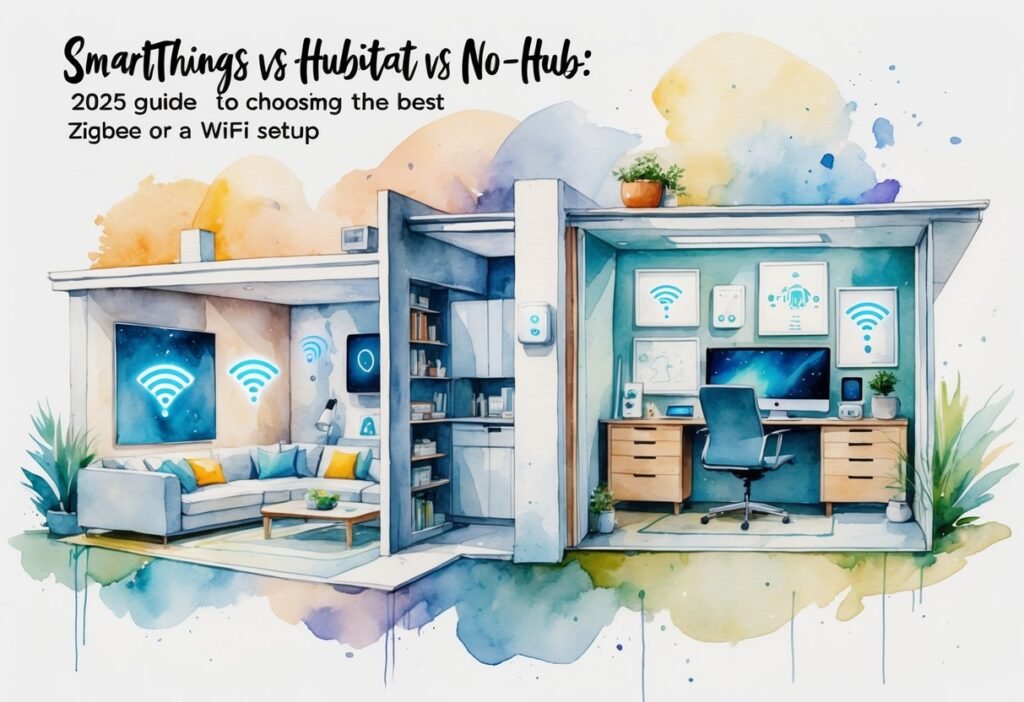
These days, a lot of smart home gear works right over Wi-Fi and can be controlled straight from an app or with your voice assistant. That means you can sometimes skip the whole hub thing. Our smart home hub comparison shows that if you mix Zigbee or Z-Wave devices and want strong local control, the smartthings vs hubitat choice becomes essential.
See today’s prices and top-rated bundles on Amazon.
Key Takeaways: SmartThings vs Hubitat—Who Wins for Your Home?
- You don’t always need a dedicated hub for your smart home in 2025.
- Both hubs support Zigbee/Z-Wave, but in smartthings vs hubitat local control tests, Hubitat runs more logic locally while SmartThings keeps setup easier.
- Wi-Fi-only and voice assistant setups are simple, but might not do everything.
✅ Do You Need a Hub—or SmartThings/Hubitat—in 2025? (When No-Hub Works)
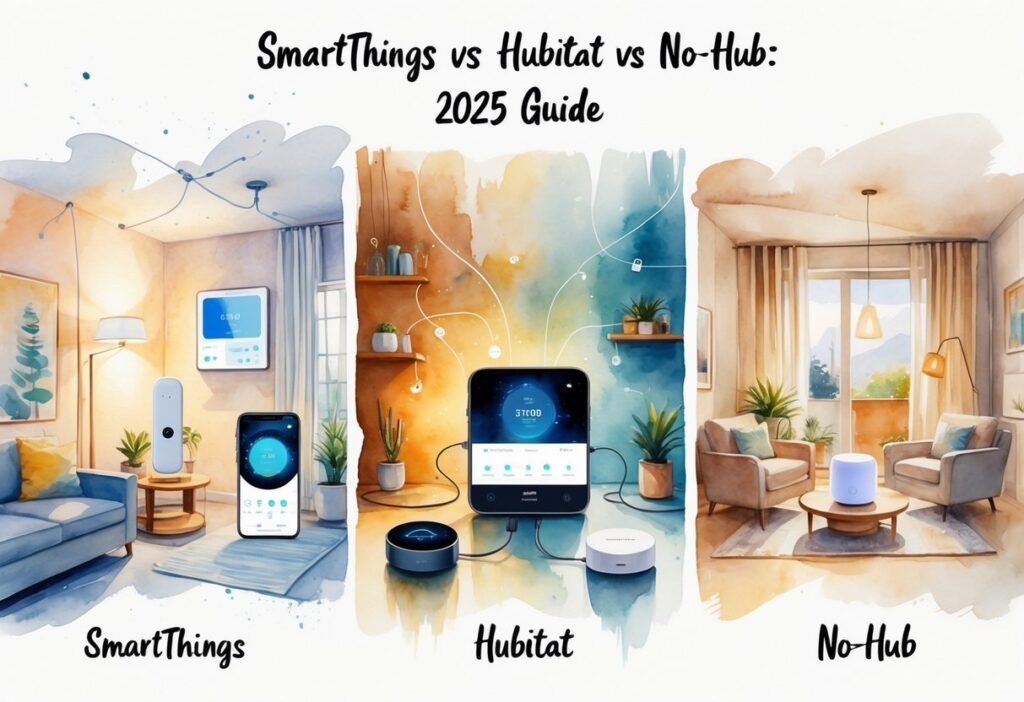
Whether you need a hub or not depends on your home and automations—but smartthings vs hubitat 2025 is the real decision once you want sensors and local control. This is why many choose the best smartthings hub for easy setup, while others prefer Hubitat for local control. In this smart home hub comparison, platforms like SmartThings and Hubitat stand out for advanced automation power.
Best Smart Home Hub 2025: Where SmartThings vs Hubitat Fits for Beginners
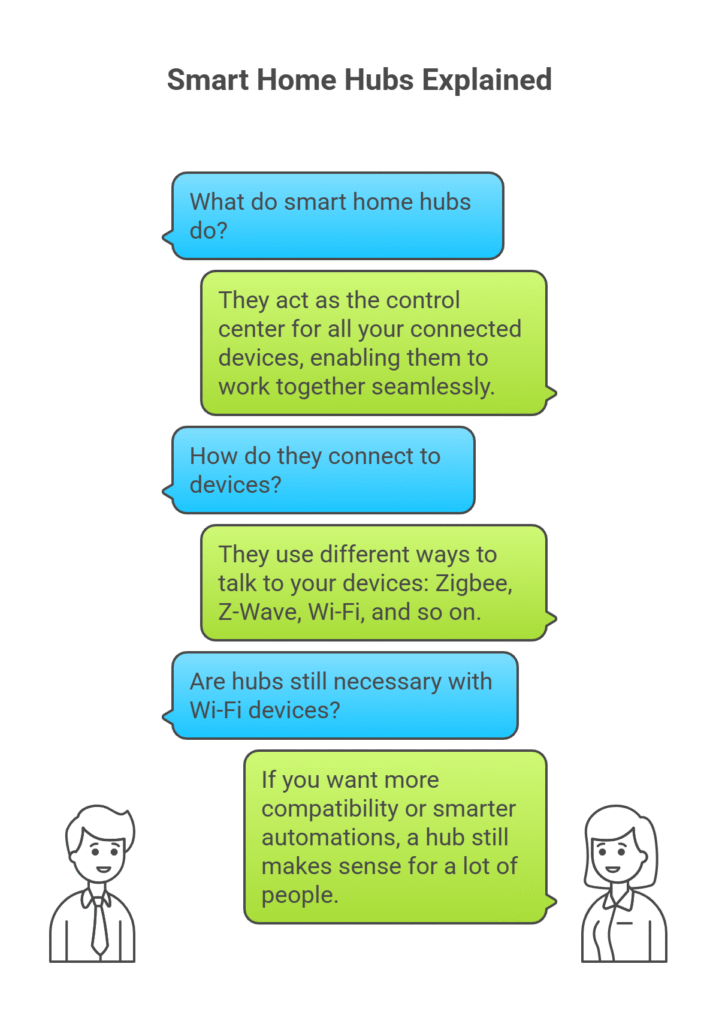
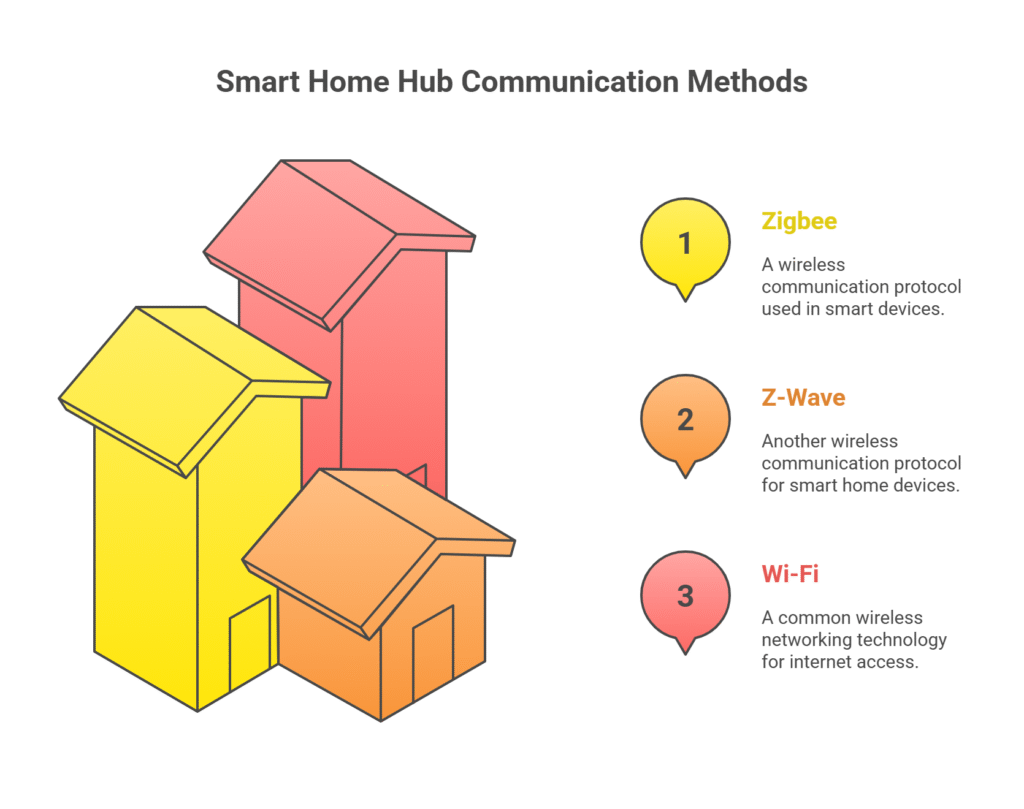
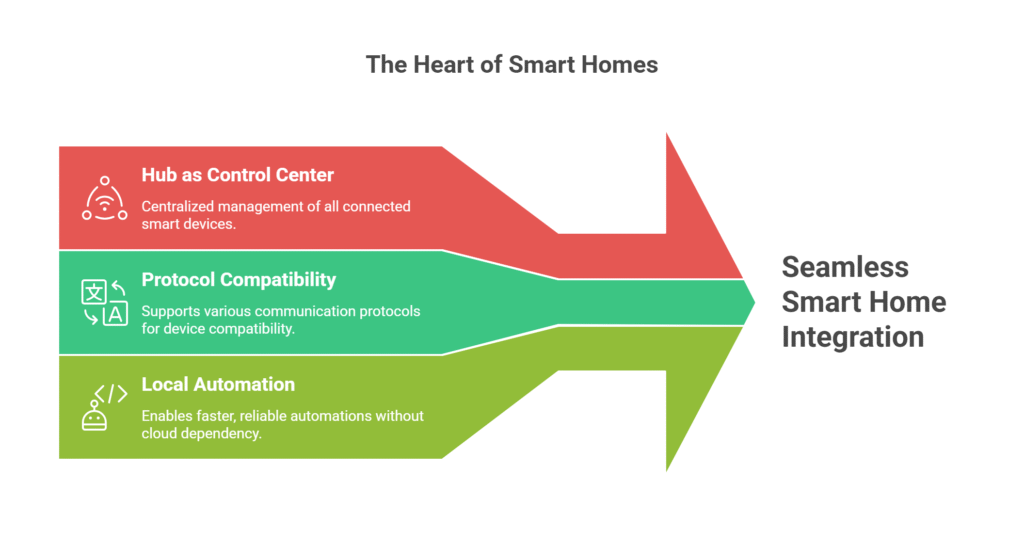
As this smart home hub comparison shows, the best hubs act as the control center; in smartthings vs hubitat, SmartThings simplifies onboarding while Hubitat focuses on privacy and speed. It lets different brands and types of devices—lights, locks, sensors, whatever—work together. Hubs like Samsung SmartThings, Hubitat Elevation, and Aeotec pull everything into one app, which is just less of a headache.
These hubs use different ways to talk to your devices: Zigbee, Z-Wave, Wi-Fi, and so on. That keeps your gadgets organized and easy to control. Plus, a hub can make things faster and more reliable by running automations locally, not just through the cloud.
Sure, some new smart home gear just runs on Wi-Fi and skips the hub. But if you want more compatibility or smarter automations, a hub still makes sense for a lot of people.
SmartThings/Hubitat vs No-Hub: Which Setup Wins in 2025?
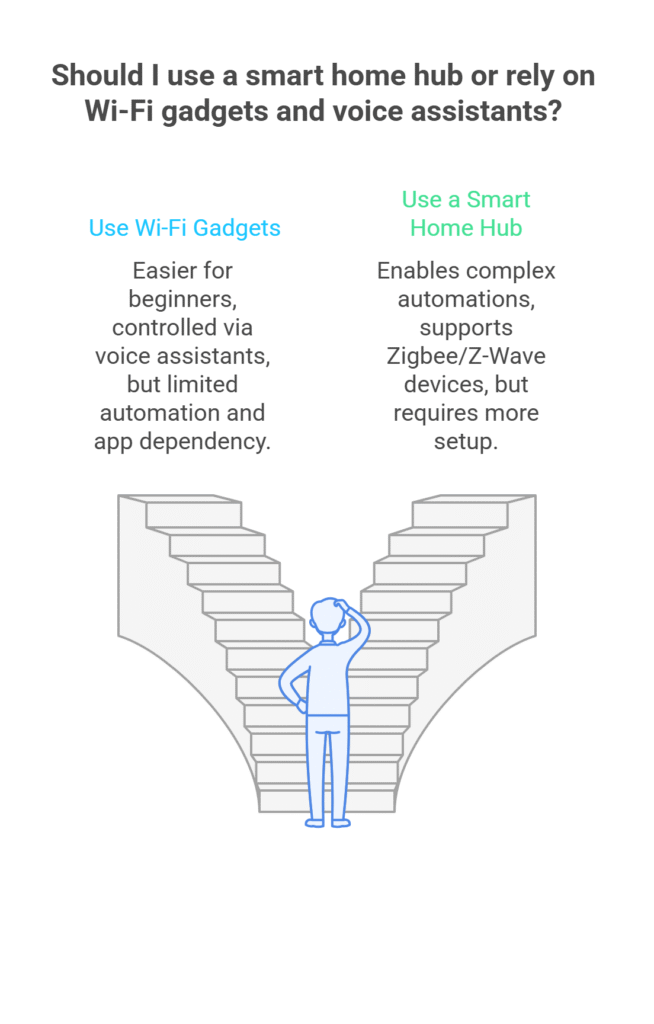
Some people just don’t bother with a hub at all. Instead, they go with Wi-Fi gadgets and control everything with voice assistants like Alexa, Google Assistant, or Apple HomeKit. For beginners, this is honestly the easiest way to get started—just use your phone or smart speaker.
But here’s the catch: Wi-Fi devices often need separate apps, and they won’t match smartthings vs hubitat reliability for complex routines. Automations can be limited, too. Voice assistants are getting better at routines, but if you want complex or local automations, you’ll hit a wall without a hub.
So, if you’ve got a bunch of devices or want more reliable, advanced automations, a hub becomes pretty important. It’s also the only way to reliably use sensors, switches, or anything with Zigbee or Z-Wave.
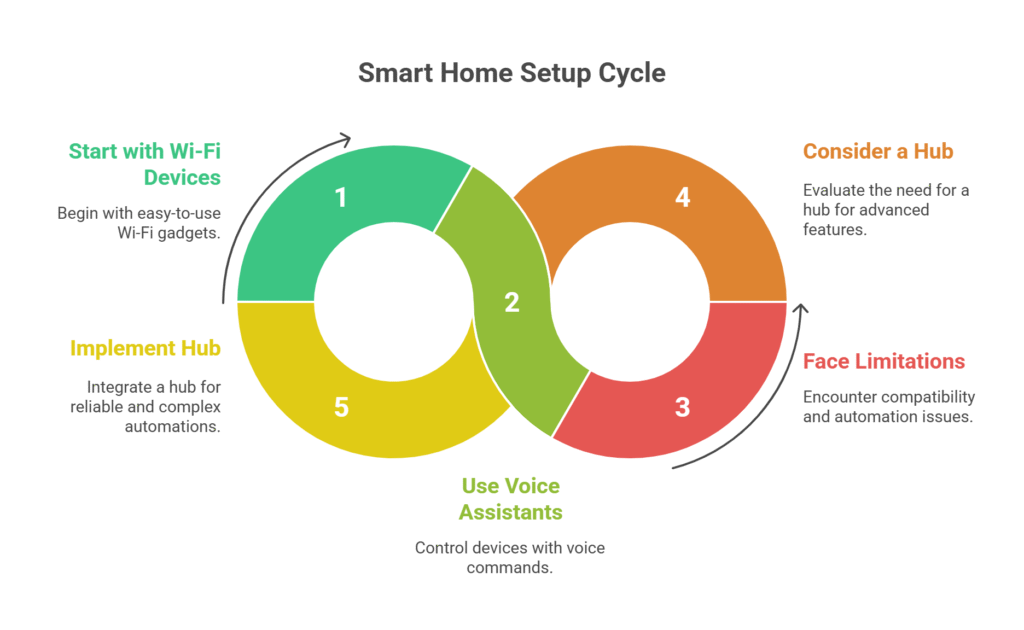
SmartThings vs Hubitat Pros & Cons (Plus No-Hub Trade-Offs)
Benefits:
- Everything’s in one place—much less app-juggling
- Works with more brands and devices, especially Zigbee and Z-Wave
- Lets you set up smart automations and schedules
- Local processing for faster, more private control
Drawbacks:
- Costs more since you need extra hardware
- Bit of a learning curve, especially for advanced stuff
- Some hubs need the internet for remote access
SmartThings vs Hubitat pits two of the best hubs head-to-head: SmartThings for simplicity, Hubitat for local control and deeper rules. The Hubitat Elevation Hub is loved for its local control, which is great if privacy is your thing. Wi-Fi and voice-only setups are usually cheaper and easier, but you’ll miss out on some features.
SmartThings vs Hubitat: Zigbee/Z-Wave, Matter & Wi-Fi Compatibility Compared
Protocols are the languages devices use; smartthings vs hubitat matter support and Zigbee/Z-Wave stacks are key to long-term compatibility.
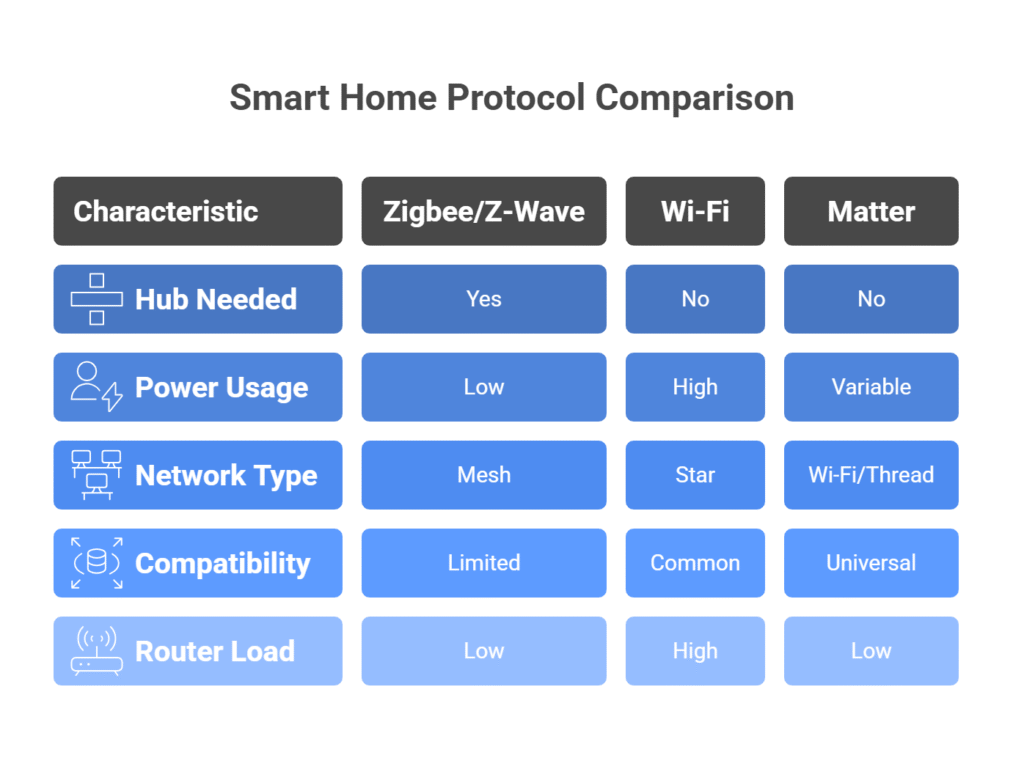
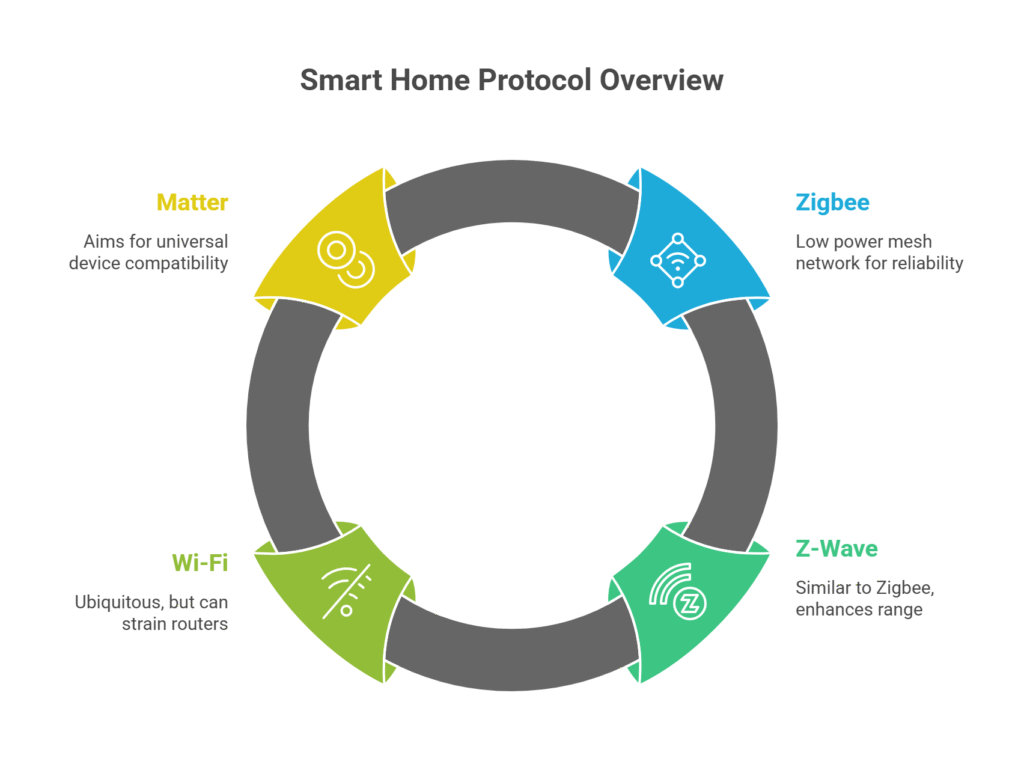
Zigbee and Z-Wave are super common for hubs. They use low power and create a mesh network, so devices can pass messages along to each other. That means better range and reliability. As this smart home hub comparison explains, some of the best home hubs like the Echo (4th Gen) add Zigbee support without requiring extra hardware.
Wi-Fi is everywhere—think smart plugs, cameras, and speakers. It doesn’t need a hub, but too many devices can bog down your router.
Matter is the new kid on the block, promising to make all smart home devices work together, no matter the brand. Matter runs over Wi-Fi or Thread (another wireless thing), and should make compatibility headaches go away—well, that’s the hope.
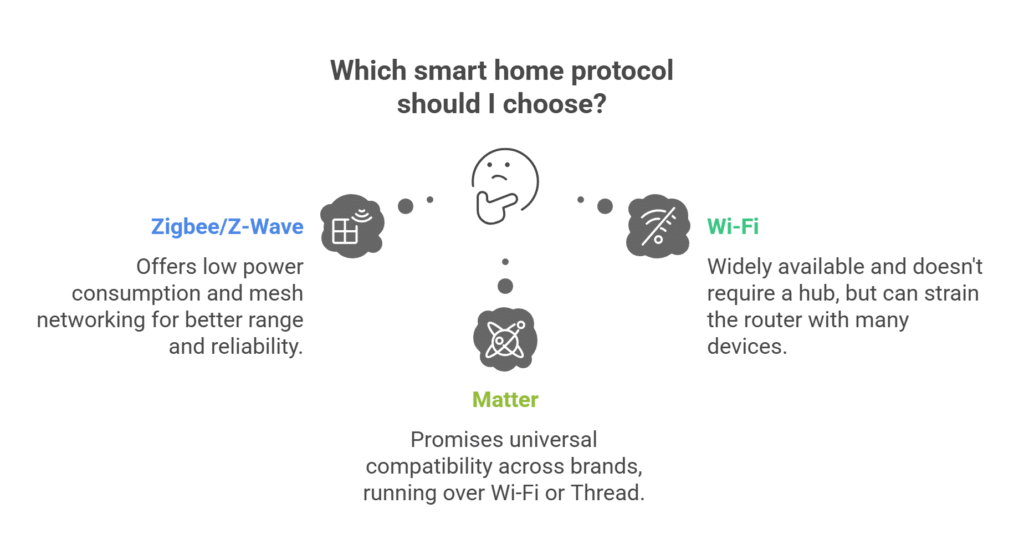
Picking between Zigbee, Z-Wave, Matter, or just Wi-Fi? It depends on how many devices you have, what you want them to do, and if you care about advanced automations. Some hubs now support more than one protocol, which is a lifesaver for mixed setups.
🔬 Matter vs Thread—and where smartthings vs hubitat matter support stands in 2025
Confused about the difference between Matter and Thread? Here’s a simple breakdown to help you understand how they work together to power the future of smart homes.
| 🔍 Feature | Matter | Thread |
|---|---|---|
| What It Is | An open smart home standard that allows devices from different brands to work together seamlessly. | A wireless mesh networking protocol designed for low-power smart home devices (like sensors). |
| Main Purpose | Ensures device interoperability across ecosystems (Apple, Google, Amazon, etc.). | Provides fast, local, and energy-efficient device communication within your home. |
| Requires Hub? | Not always. Some Matter devices work with voice assistants or via Wi-Fi/Thread routers. | Yes — requires a Thread Border Router (like Nest Hub or Apple HomePod Mini). |
| Example Devices | Smart plugs, bulbs, locks, thermostats from brands like Eve, Nanoleaf, and TP-Link. | Motion sensors, door/window sensors, and other low-power accessories. |
🚀 Matter-Ready Picks That Work with SmartThings or Hubitat (2025)
New Matter/Thread devices improve compatibility; most work with SmartThings and Hubitat, reinforcing the smartthings vs hubitat choice rather than replacing it. Whether you’re using a dedicated best smartthings hub, a Hubitat model, or going hub-free with voice assistants, these new Matter-certified gadgets work seamlessly across ecosystems and are designed to simplify setup while offering more robust automation. Below are three standout devices—all available on Amazon—that weren’t mentioned in the original comparison but are quickly becoming must-haves for modern smart homes in 2025.
🔧 Expert Picks: Trending Devices You Should Know
1. Eve Energy (Matter + Thread) Smart Plug
- Why it’s trending: Fully Matter-enabled over Thread, it works natively with Apple Home, Google Assistant, Amazon Alexa, and SmartThings without needing a hub. Users also rave about its built-in energy monitoring and privacy-first design, and it doubles as a Thread range extender.
- Best for: Privacy-conscious users wanting reliable Matter devices plus energy insights.
- Eve Energy requires iOS/iPadOS 16.4 (or later) or Android 8.1 (or later) plus a hub of your chosen…
- Eve Energy requires iOS/iPadOS 16.4 (or later) or Android 8.1 (or later) plus a hub of your chosen…
- Switch your lights and appliances on and off using your voice or an app, and control your appliances…
Last update on 2025-11-12 / Affiliate links / Images from Amazon Product Advertising API
2. Kwikset Halo Select Smart Lock (Matter-over-Thread)
- Why it’s trending: One of the first full-replacement smart locks supporting Matter-over-Thread. It offers auto-unlock geofencing, Wi-Fi or Matter connectivity, integration with all major ecosystems, and excellent battery life.
- Best for: Users needing a secure, future-proof door lock with uniform compatibility and minimal hub reliance.
- CONTROL AND MONITOR FROM ANYWHERE: Remotely lock and unlock, share guest access and ensure your door…
- SMART HOME INTEGRATION: Works with Amazon Alexa, Apple Home, and Google Home. Control your lock with…
- CONVENIENT KEYLESS ENTRY: Enable intelligent geofencing to automatically unlock as you approach your…
Last update on 2025-11-12 / Affiliate links / Images from Amazon Product Advertising API
3. TP-Link Tapo HomeBase H500 + MagCam 4K Solar Cameras
- Why it’s trending: The HomeBase H500 acts as a Matter controller supporting TP-Link’s new battery-powered solar cameras like the MagCam 4K and VistaCam 360. It offers facial recognition, local storage, and works without monthly subscription.
- Best for: Buyers wanting cloud-free camera setups integrated into Matter and home monitoring without ongoing fees.
- Solid expandable memory without subscription costs with integrated 16GB eMMC, extends up to 16TB…
- Advanced AI-supported detection features with high-precision facial recognition technology plus…
- Central hub for comprehensive smart home control, supports connections up to 16 tapo…
- 𝐐𝐮𝐢𝐭𝐞 𝐏𝐨𝐬𝐬𝐢𝐛𝐥𝐲 𝐭𝐡𝐞 𝐏𝐞𝐫𝐟𝐞𝐜𝐭…
- 𝟒𝐊 𝐔𝐥𝐭𝐫𝐚 𝐇𝐃 𝐂𝐥𝐚𝐫𝐢𝐭𝐲 – Experience 4× the resolution…
- 𝐂𝐨𝐦𝐩𝐥𝐞𝐭𝐞 𝐀𝐫𝐞𝐚 𝐂𝐨𝐯𝐞𝐫𝐚𝐠𝐞 – Enjoy 360º…
Last update on 2025-11-12 / Affiliate links / Images from Amazon Product Advertising API
SmartThings vs Hubitat (2025) vs No-Hub: Real-World Results & Use Cases
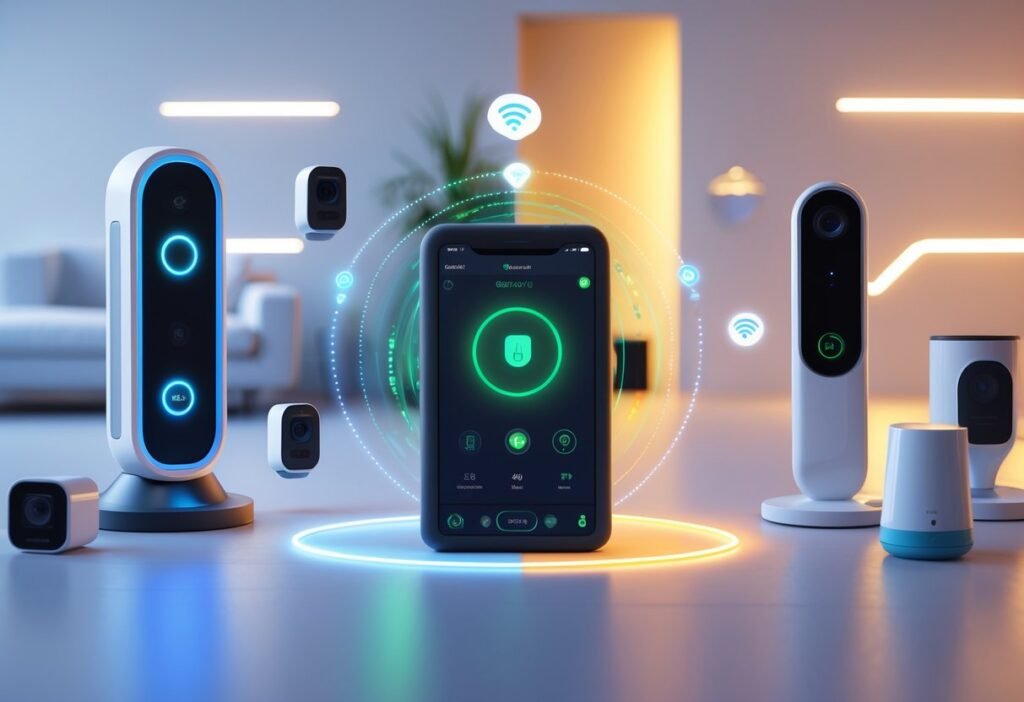
This 2025 comparison delivers smartthings vs hubitat 2025 results so beginners can balance privacy, local control, and budget. Whether you want a full-featured hub or just stick with your voice assistant, each option has its own strengths, quirks, and long-term trade-offs.
SmartThings, Hubitat & Aeotec in 2025: Which Hub Fits Your Devices?
Samsung SmartThings hubs—including the best smartthings hub Station—aim for ultra-simple onboarding; pair that with Aeotec Smart Home Hub vs Hubitat if you want Z-Wave and Zigbee bridges. Most of the control runs through the cloud. It’s good with Zigbee, Z-Wave, and Wi-Fi, and works with Google Assistant and Alexa right out of the box. The Aeotec Smart Home Hub mirrors SmartThings features and serves many buyers searching aeotec smart home hub vs hubitat comparisons.
- Monitor and control compatible devices in your home using a single smartphone app for your phone
- Automate connected devices in your home and set them to turn on or off when doors are opened, people…
- Works with a wide range of smartphone compatible products
Last update on 2025-11-12 / Affiliate links / Images from Amazon Product Advertising API
Hubitat Elevation is all about local control—the core of smartthings vs hubitat performance differences. It keeps everything running in your house, not in the cloud, so if your internet goes down, your automations still work. That’s a big plus if you care about privacy or reliability. It supports Zigbee and Z-Wave, but setup takes a bit more effort.
- Speed: Automations are processed locally on the hub for fast, reliable home automation
- Compatibility: Compatible with most Zigbee, Z-Wave, LAN, Google Home, Alexa and Lutron devices…
- Customizable: Dozens of built-in automation apps for customizing your smart home
Last update on 2025-11-12 / Affiliate links / Images from Amazon Product Advertising API
No-hub setups lean hard on Wi-Fi devices that connect straight to apps or speakers like the Amazon Echo (which has Zigbee built in) or Google Home. These are pretty much plug-and-play, but you’ll notice limits with automations and older devices that use Z-Wave or Zigbee.
- [Multi-Protocol Hub with Matter Bridge] The M3 is a versatile hub supporting Aqara Zigbee and Thread…
- [Edge Compatibilities and Local Automations] The M3 serves as an Edge Hub, prioritizing local…
- [Smart IR Blaster with Feedback and Learning] The 360°IR blaster not only sends commands but also…
Last update on 2025-11-12 / Affiliate links / Images from Amazon Product Advertising API
Setup & Automation: SmartThings Routines vs Hubitat Rule Machine (Local)
SmartThings and Aeotec—among the best hubs—shine at onboarding; meanwhile hubitat rule machine vs smartthings routines defines long-term automation depth. The app walks you through everything, step by step. Most people find adding new devices quick and painless, with the app usually spotting them automatically. You can set up automations and routines easily, managing your lights, sensors, and other gadgets from your phone.
Hubitat Elevation, though, is more for tinkerers. The dashboard isn’t as slick as SmartThings, but you get much deeper local control. Its Rule Machine is powerful—you can build custom automations with triggers, delays, and all sorts of conditions. If you like tweaking every detail, Hubitat is flexible, but it’s not really for beginners.
No-hub setups are the easiest to get going. Most Wi-Fi smart devices can be added to Alexa, Google Home, or Apple HomeKit in just a few minutes. The downside is, unless you dive into open-source stuff like Home Assistant Green or a Raspberry Pi, you won’t get advanced routines or scenes. And, let’s be honest, learning YAML code isn’t for everyone.
Compatibility Guide: SmartThings vs Hubitat for Zigbee/Z-Wave & Matter
SmartThings and Aeotec cover many brands with Zigbee/Z-Wave/Wi-Fi; if you’re comparing smartthings vs hubitat zigbee z-wave, note Hubitat’s local device handling. They play nice with most popular bulbs (Philips Hue, for example), switches, thermostats, smart locks, sensors, and outlets. In this smart home hub comparison, the best smart home hubs like SmartThings and Aeotec stand out for easy setup, wide compatibility, and voice assistant integration.
Hubitat Elevation is a champ at local automation and lets you build custom rules. Advanced users can install custom drivers and community apps, so you can support weird devices or niche automations. It also works with Hue, Lutron, Zooz, and more. If you’re techy, you can even integrate with Home Assistant, HomeKit, or Node-RED.
No-hub setups mostly stick to Wi-Fi smart devices. Anything older that uses Z-Wave or Zigbee needs a bridge or hub. Plug-and-play is great for simple stuff, but advanced scenes or custom actions are limited. Open-source options like Home Assistant or Homebridge add flexibility, but you’ll have to get your hands dirty with DIY setup and some technical know-how.
Comparison Matrix: SmartThings vs Hubitat vs No-Hub (Price, Ease, Privacy)
A variety of smart home hubs (multi-protocol devices) including SmartThings and Hubitat Elevation. This matrix gives a side-by-side smartthings vs hubitat view (plus No-Hub) so you can pick the right fit fast.
In the matrix below, we compare four leading smart home solutions to give a concise overview of their similarities and differences. This product comparison chart highlights the key criteria—ease of use, compatibility (Zigbee/Z-Wave support and more), automation capabilities, privacy/local control, and price—for each option. By clearly defining these criteria up front, we focus on the most relevant factors and avoid unnecessary comparisons. Each hub is evaluated uniformly across these points, making it easy to weigh the trade-offs and identify which setup best aligns with your priorities.
| Criteria | Samsung SmartThings Station | Hubitat Elevation | Aeotec Smart Home Hub | No-Hub Setup (Alexa/Google) |
|---|---|---|---|---|
| Ease of Use | Beginner-friendly app with step-by-step setup; very intuitive. | Advanced setup for tech-savvy users; more manual configuration. | Easy-to-use SmartThings app, but slightly more complex features. | Simplest setup; voice assistants and apps make onboarding fast. |
| Compatibility | Zigbee, Wi-Fi, Thread/Matter (no Z-Wave). | Zigbee, Z-Wave, and Matter support; excellent for mixed devices. | Supports Zigbee, Z-Wave, Wi-Fi, and Thread/Matter; wide coverage. | Mostly Wi-Fi; limited Zigbee/Thread via Echo or Nest hardware. |
| Automation Capabilities | Cloud-based with support for routines; some local via Edge drivers. | Powerful local automation with advanced Rule Machine engine. | SmartThings-based routines; similar automation power as Samsung hub. | Basic cloud routines and voice triggers; lacks multi-condition logic. |
| Privacy & Local Control | Mixed—part cloud, part local with Edge; needs internet for full features. | Full local processing; strong privacy; works offline without cloud. | Cloud-based with partial local automation via SmartThings Edge. | Fully cloud-based; no offline automation; voice data processed externally. |
| Deals | Check Price | Check Price | Check Price | Echo/Nest Deals |
📊 Click here for Deep Dive Comparison
Full Smart Home Hub Comparison Matrix (2025)
Explore every detail—from Zigbee compatibility to privacy trade-offs—before choosing your smart setup. Want all the details before committing to your smart home setup?
This comprehensive matrix breaks down each hub’s strengths, weaknesses, and unique features across automation, privacy, compatibility, and more. Perfect for power users, tinkerers, or anyone investing in a long-term smart home plan.
| Criteria | Samsung SmartThings Station (SmartThings Hub – Samsung) |
Hubitat Elevation (Model C-7/C-8 Hub) |
Aeotec Smart Home Hub (Works as SmartThings Hub) |
No-Hub Setup (Wi-Fi + Voice Control via Alexa/Google) |
|---|---|---|---|---|
| Ease of Use | Very beginner-friendly. Uses the polished SmartThings mobile app for setup and control, with guided device pairing and an intuitive interface. Minimal technical effort required – great for newcomers to smart homes. | Steeper learning curve. Designed for power users, Hubitat’s interface is less slick and more technical, requiring some tinkering and learning. Initial setup and rule creation demand more effort, so it’s best suited to tech-savvy enthusiasts. | Moderately easy. Runs on the SmartThings app (user-friendly overall), but the extensive features can overwhelm absolute beginners. In practice it’s straightforward to get running, yet some users report the interface feels complex until you get used to it. | Simplest option. No extra hub device needed – just connect Wi-Fi gadgets via their apps and link your voice assistant. Essentially plug-and-play for basic use. Easiest for beginners, though managing many devices from different brands may require juggling separate apps (since there’s no unified hub app). |
| Compatibility | Zigbee, Wi-Fi, Thread/Matter, BLE. Supports all modern protocols except Z-Wave. (※ The SmartThings Station does not have a Z-Wave radio, so it can’t directly control Z-Wave devices – that’s where the Aeotec hub comes in.) Works out-of-the-box with a wide range of new smart bulbs, plugs, sensors, and more (including Matter devices). | Zigbee & Z-Wave built-in, plus Matter. Hubitat has both Zigbee and Z-Wave radios for legacy devices and now supports Matter on the C-8 model. Also integrates with major ecosystems (Alexa, Google, and even HomeKit) for broad compatibility. You can mix and match devices freely, with no cloud bridges required for Zigbee/Z-Wave gear. | Multi-protocol powerhouse. Supports Z-Wave, Zigbee, Wi-Fi, and Thread/Matter in one hub. This hub is essentially a SmartThings V3, so it works with practically everything – from Alexa and Google Assistant to a huge list of third-party sensors and devices. | Mostly Wi-Fi only. Devices rely on Wi-Fi (or Bluetooth) and cloud-to-cloud links; there’s no native Z-Wave support in Alexa/Google systems. Some smart speakers do include extra radios (e.g. Amazon Echo has Zigbee, Nest has Thread), but most setups are limited in protocol variety compared to a dedicated hub. |
| Automation | Robust cloud-based automation. SmartThings supports fairly complex routines with multi-condition “if this, then that” logic via its app. Automation setup is user-friendly, and new SmartThings Edge drivers enable many automations to run locally for faster response. However, some advanced rules or third-party integrations still rely on cloud processing. | Advanced local automations. Hubitat excels at automation: its Rule Machine app lets you create very sophisticated, custom triggers and actions. All routines execute locally on the hub, ensuring quick responses and functionality even if the internet is down. This depth of automation is ideal for enthusiasts who want total control (but it can be overkill for simple needs). | SmartThings-grade automations. Because it runs SmartThings software, the Aeotec hub offers the same powerful scenes and schedules as Samsung’s hub. You can combine devices across protocols in one routine and set up complex conditions/timers. Like SmartThings, it may depend on cloud connectivity for certain cross-device or voice-driven automations. | Basic routines & voice control. You’re limited to what Alexa, Google Assistant, or HomeKit can do natively. Simple schedules and voice-triggered actions are supported, but multi-step or highly conditional logic is very limited. Everything runs through the cloud, which can introduce slight delays. |
| Privacy & Local Control | Mixed (cloud + some local). SmartThings is historically cloud-centric – most commands and data go through Samsung’s servers. The system has added local control (SmartThings Edge lets certain device drivers and automations run on the hub itself), but it remains more cloud-dependent than a hub like Hubitat. | High (local-first). Privacy and offline reliability are strong points for Hubitat. All device data and automation logic stay on the local hub by default – nothing is sent to the cloud unless you opt in. Even with no internet, your Zigbee/Z-Wave devices and rules keep working. | Mixed (cloud + some local). The Aeotec hub uses the SmartThings platform, so it shares the same cloud reliance for account management and third-party integration. Zigbee/Z-Wave automations can run locally, but voice or internet-based services stop working without connectivity. | Low (cloud-dependent). No-hub setups are fully cloud-based—every command or automation goes through Amazon/Google servers. If your internet is down, most smart features won’t function. Also, usage and voice data are routinely processed by third-party providers. |
| Price | $$ – Affordable. SmartThings Station hub costs about $80 retail and has no monthly fees. It’s a one-time hardware purchase that unlocks wide smart home compatibility. | $$$ – Mid-range. Hubitat Elevation costs $130–$150. No subscriptions needed for core features. Optional extras like remote access or cloud backups exist, but aren’t required. | $$ – Mid-range. Roughly $120. Offers broad support without subscription fees. Users benefit from long-term value without ongoing platform charges. | $ – Budget-friendly. No hub needed if using an app or voice speaker. Many start with just a free app or a $50 Amazon Echo Dot. Lowest initial cost overall. |
FAQ: SmartThings vs Hubitat—Beginners’ Questions in 2025
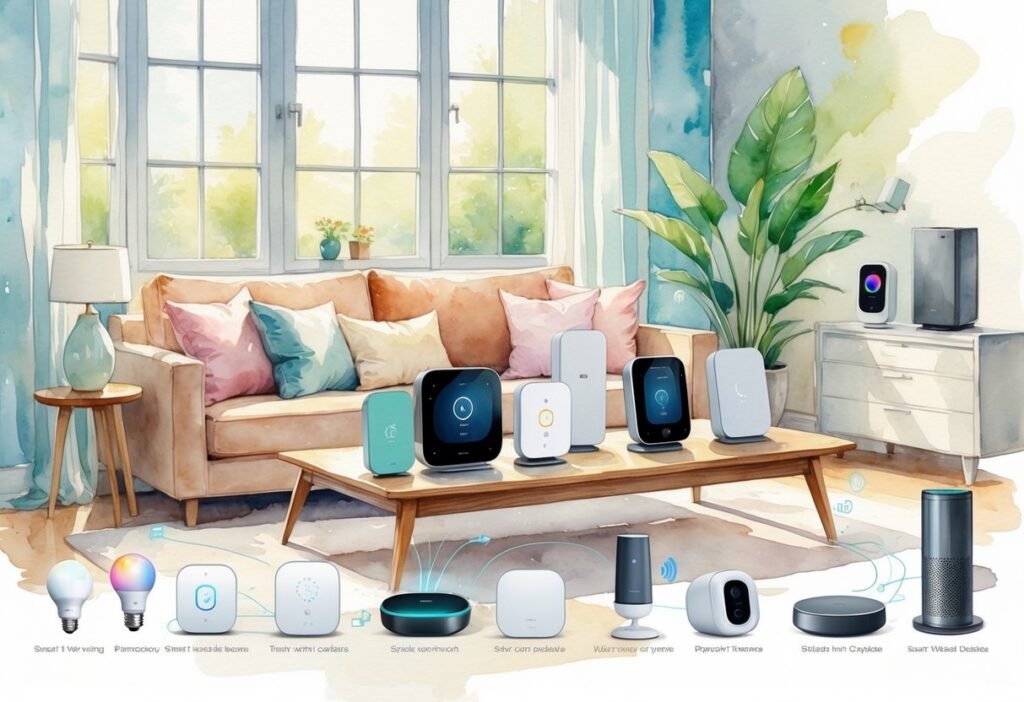
Picking the right hub comes down to your devices and routines; our smartthings vs hubitat guide explains when the best smartthings hub is enough and when Hubitat wins. Do you care more about automation, privacy, or just making sure everything talks to each other? There are a few ways to go—dedicated hubs, Wi-Fi-only setups, or just using a voice assistant—and honestly, each has its perks depending on your situation.
SmartThings vs Hubitat: what are the benefits of a dedicated hub in 2025?
In smartthings vs hubitat zigbee z-wave comparisons, both use low-power mesh radios that are usually more reliable than Wi-Fi for control. The big win here is local processing—your lights or sensors can still work even if your internet goes out. That’s pretty reassuring.
You also get more advanced automations and support for a bunch of different sensors and switches. Plus, there’s usually less data sent to the cloud, so you get a bit more privacy, which is always nice.
How do Samsung SmartThings, Hubitat Elevation, and Aeotec compare (and when to pick each) in smartthings vs hubitat 2025?
Samsung SmartThings is pretty user-friendly and plays nicely with a lot of popular brands. Since the original SmartThings hub is retired, most people use it with the Aeotec Smart Home Hub these days. Hubitat Elevation, on the other hand, is a favorite for folks who want everything processed locally and don’t want to rely on the cloud. It’s a bit more technical, but the privacy and automation options are hard to beat.
Aeotec basically brings all the SmartThings features and acts as a bridge for Zigbee, Z-Wave, and Wi-Fi gear. So, if you’re after compatibility, it’s a solid pick.
No-hub vs smartthings vs hubitat: when do Wi-Fi/voice assistants make more sense?
Honestly, using a voice assistant like an Amazon Echo (4th Gen) or just Wi-Fi is super easy. Most new smart plugs, bulbs, and cameras work with Alexa, Google Assistant, or Apple HomeKit right out of the box. Setup is usually quick, too.
But here’s the catch: Wi-Fi devices depend on the cloud and can slow down your home network if you have a bunch of them. If your internet goes out, a lot of things just stop working. Automation is also more basic compared to what you get with a dedicated hub.
Which smart home hubs offer the best compatibility with Zigbee devices?
The Samsung SmartThings Station and Aeotec Smart Home Hub both do a great job with Zigbee. The Hubitat Elevation Hub is also a top pick if you want to pair Zigbee sensors, bulbs, and other gadgets and keep everything running locally. That’s a big plus for reliability.
What alternatives exist for users looking for a system similar to the retired Samsung SmartThings hub?
The Aeotec Smart Home Hub has basically stepped in as the new main hub for SmartThings. Hubitat Elevation is another solid option, especially if you want more local control and similar device support. You might also check out Aqara Hub, Home Assistant, or even an Amazon Echo with built-in Zigbee. There’s no shortage of choices, honestly.
Can smart home devices operate effectively without a central hub by utilizing existing Wi-Fi networks?
A lot of smart plugs, bulbs, and cameras just use Wi-Fi these days, so you can usually control them right from your phone or with a voice assistant. For most basic stuff—like turning things on or off or setting up simple schedules—you honestly don’t need a separate hub.
But if you’re thinking about more complicated setups, say with Zigbee or Z-Wave sensors, or you want your automations to run more smoothly, then yeah, a hub tends to be necessary.
What is a smart home hub?
A smart home hub is a central device that connects and controls your smart devices—such as lights, thermostats, sensors, and locks—even if they use different technologies like Zigbee, Z-Wave, or Wi-Fi. It acts as the brain of your smart home, enabling automation routines and device coordination.
Can I run home automation without a hub?
Yes, you can. Many smart devices today connect directly to your Wi-Fi and work with voice assistants like Amazon Alexa or Google Home—without the need for a hub. However, using a hub offers better automation control, faster performance, and offline functionality for Zigbee/Z-Wave devices.
Is Hubitat better than SmartThings?
It depends on your needs:
- Hubitat is better for advanced users who value local automation, privacy, and speed.
- SmartThings is more beginner-friendly with a polished app and strong Samsung ecosystem integration.
Choose Hubitat if you want power-user features. Choose SmartThings if you prefer convenience and a smoother setup.
What are the pros and cons of using a smart home hub?
Pros:
- Centralized control of many devices
- Improved automation (especially local routines)
- Supports Zigbee and Z-Wave networks
Cons:
- Additional setup and cost
- Steeper learning curve for advanced hubs
- Might not be needed for simple Wi-Fi setups
Which is best for beginners in smartthings vs hubitat (2025)?
For most beginners, SmartThings is the easiest to start with. It has a user-friendly app, broad compatibility, and support from Samsung.
For tech-savvy users who want local control and data privacy, Hubitat is a solid alternative.
Is SmartThings or Hubitat better for Zigbee/Z-Wave in 2025?
Both support Zigbee/Z-Wave, but Hubitat runs automations locally for faster, offline-friendly routines. SmartThings is easier to set up and integrates tightly with Samsung gear.
Does SmartThings or Hubitat support Matter today?
Both platforms continue to expand Matter support. Check device firmware and hub release notes; results vary by brand and model.
Are SmartThings routines as powerful as Hubitat Rule Machine?
SmartThings routines are simpler for beginners. Hubitat Rule Machine offers deeper, condition-based logic and local execution.
Related Posts
DIY Home Security Systems: Top 5 Smart Alarm Kits Compared for Features and Subscription Options
Indoor & Outdoor Smart Cameras: 5 Best Security Cameras for Easy Home Monitoring
Top 10 Must-Have Smart Home Gadgets in 2025 for Beginners: Essential Devices and Easy Upgrades





![SmartThings Hub 3rd Generation [GP-U999SJVLGDA] Smart Home Automation...](https://m.media-amazon.com/images/I/21hChu0ounL._SL160_.jpg)

